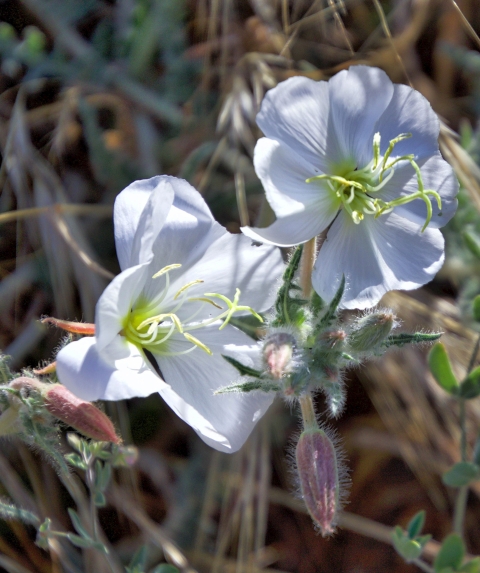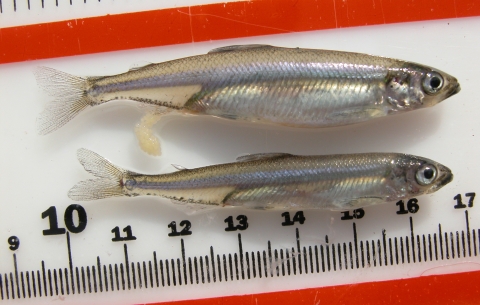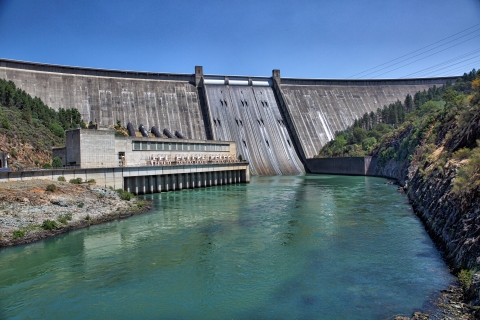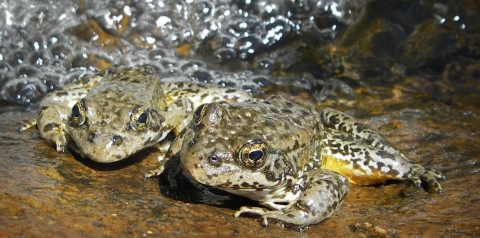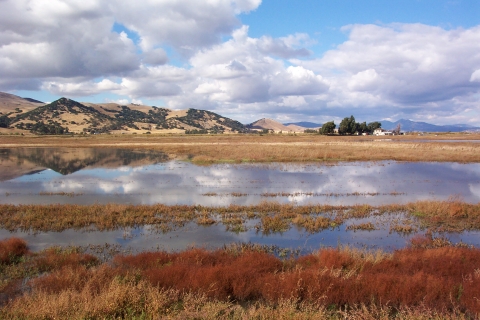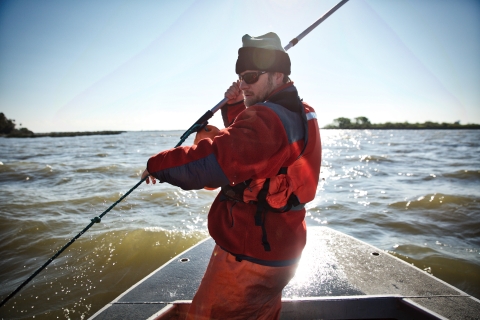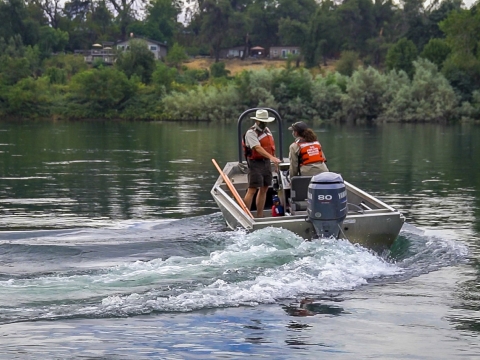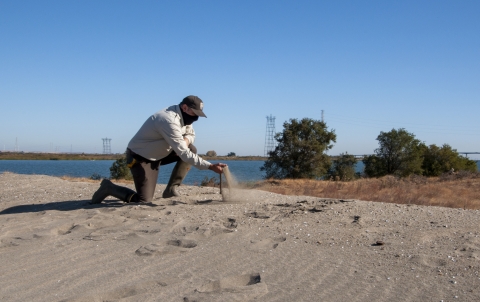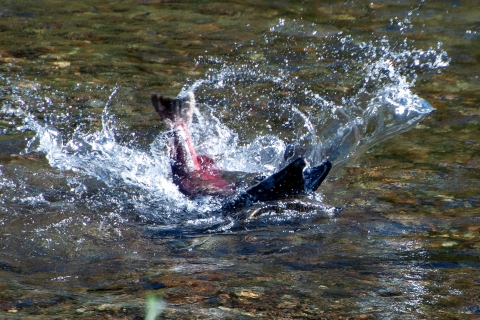What We Do
The Bay-Delta office works to protect threatened and endangered species in diverse habitats such as tidal marsh, rivers and sand dunes. Our coverage area includes the San Francisco, San Pablo and Suisun bays, Sacramento-San Joaquin River Delta, Yolo Bypass and their surrounding areas. For water storage projects and hydropower regulation issues, our team extends its expertise upstream to the Sacramento and San Joaquin rivers and their tributaries. Among other activities, we:
- Evaluate species for listing as endangered (in danger of extinction throughout all or a significant portion of its range) or threatened (likely to become endangered);
- Consult on development projects and provide recommendations to avert, minimize or compensate for negative impacts to wildlife and their habitats;
- Work with landowners, nongovernmental organizations and other agencies to develop cooperative conservation strategies, including recovery plans and conservation banks;
- Conduct biological studies to increase understanding of at-risk species and enhance restoration efforts; and
- Identify sources of environmental contaminants and work to reduce their effects.
Management and Conservation
Species Assessment and Listing
We evaluate species to determine if they require protection under the Endangered Species Act and provide conservation recommendations to reduce threats to species.
This process emphasizes coordination with states and other partners to gather the best available information on species and conservation. This also provides the foundation for planning and implementing voluntary conservation efforts.
The Endangered Species Act requires the Service to review the status of each endangered species (those in danger of extinction) and threatened species (those that are likely to become endangered) at least once every five years.
Recovery Permits
Many scientists outside the Service join in the recovery effort, studying endangered species. To do so, they obtain recovery permits, which allow them to conduct activities that would otherwise be prohibited by the Endangered Species Act. Their research enhances our understanding of at-risk species and their long-term survival needs.
Recovery permits may be issued for activities including but not limited to presence/absence surveys, monitoring populations, capture studies, marking and tracking, captive breeding and/or rearing, collecting genetic samples for research activities, and performing educational programs that further the recovery of a threatened or endangered species.
Bay Restoration Regulatory Integration Team (BRRIT)
Bay-Delta is one of six members that worked to establish the Bay Restoration Regulatory Integration Team, or BRRIT. Founded in 2019, the BRITT improves permitting efficiency for habitat-restoration, flood-management and public-access infrastructure projects in the San Francisco Bay and the shoreline of nine Bay Area counties.
The BRITT's six federal and state agencies work with applicants throughout the planning process to facilitate permitting, identify potential interagency conflicts and propose solutions. The first project to complete the permitting process with BRRIT assistance was a $5 million San Francisco Recreation and Park Department contamination-cleanup project to restore habitats and enhance recreation in the Bayview-Hunter’s Point neighborhood.
Our Services
Section 7 ESA Consultations (for federal agencies)
The Bay-Delta office completes about 60 consultations per year under Section 7 of the Endangered Species Act, with the Army Corps of Engineers, Bureau of Reclamation and Federal Energy Regulatory Commission our most frequent requestors. Federal agencies are required to consult with the Service any time a federal project — or a project funded, authorized or permitted by a federal agency — may affect a threatened or endangered species or their critical habitat.
If we find a project is likely to impact a threatened or endangered species, a “formal consultation” is required. At the end of the consultation, the Service will issue a biological opinion. If the project could jeopardize a threatened or endangered species’ existence or its critical habitat, the biological opinion may recommend actions to avert or minimize those impacts. If, on the other hand, the project is not likely to jeopardize an at-risk species' existence, but will likely result in "take," we can issue an Incidental Take Statement.That statement will permit the project as long as the applicant implements certain terms and conditions.
Bay-Delta's Section 7 work includes the Reinitiation of Consultation on the Long-Term Operation of the Central Valley Project and State Water Project, implementation of the San Joaquin River Restoration Program and “programmatic consultations,” which address multiple projects at once, regarding Delta smelt and the Suisun Marsh Habitat Management, Preservation and Restoration Plan.
To learn more about the process, view the Service's Section 7 Consultations page. Bay-Delta's jurisdiction for Section 7 consultations can be viewed on this map. For water storage projects and hydropower regulation issues, Bay-Delta's coverage area includes the areas on the map plus the Sacramento and San Joaquin rivers and their tributaries.
Water Resource Planning
We partner with federal, state and local government agencies and nongovernment organizations on issues related to hydropower regulation, flood-damage reduction, habitat restoration, water-related development and water storage.
With agencies like the Army Corps of Engineers, Bureau of Reclamation, Federal Energy Regulatory Commission and California Department of Water Resources, we work to conserve fish and wildlife and their habitats during the planning process by evaluating the proposed project’s impacts to fish and wildlife and recommending alternatives to minimize negative impacts..
The Bay-Delta Office is involved with over 20 FERC-licensed hydropower projects. During relicensing of the Bucks Creek Hydroelectric Project owned by Pacific Gas and Electric, we worked extensively in collaboration with others to ensure protection of the endangered Sierra Nevada yellow-legged frog. The six-year process resulted in the utility withdrawing its operations from the Bear Ravine area, near a population of the endangered frog, eliminating potential mortality to eggs, tadpoles and young frogs.
The Service worked in partnership with multiple agencies to update the water control manual for Folsom Dam so that project operations would reduce flood risk for the Sacramento area while minimizing negative impacts to fish and wildlife and also monitoring the operations’ effects on habitats.
Find out more on the Service's Conservation Planning Assistance page.
Habitat Conservation Plans
Wildlife conservation doesn't need to conflict with growth. Our office works with landowners, county planners and other applicants to shape Habitat Conservation Plans that balance development with conservation, while streamlining the permitting process.
HCPs are designed to allow for change, while also protecting habitats. We ensure HCPs include any measures necessary to reduce projects' impacts to threatened and endangered species.
Through the HCP process, which includes a public comment period, property owners and natural resource managers become partners in maintaining sustainable habitats.
The HCP for a road and flood-protection levee at the Sacramento Regional County Sanitation District's South River Pump Station, for instance, required the District to reduce or offset impacts to two threatened species — the giant garter snake and valley elderberry longhorn beetle. Among other measures, the plan called for transplanting elderberry shrubs from the site to a conservation bank and restoring snake habitat.
Recovery Planning
Our scientists work with outside experts and other interested parties to develop and implement strategies to recover threatened and endangered species and ultimately remove them from protected status. Our Northern and Central California Tidal Marsh Recovery Plan, for example,focuses on recovering 17 species of imperiled birds, plants and animals. Learn more on our California Tidal Marsh Ecosystem Recovery page and in our Frequently Asked Questions. Public comments are requested on all draft recovery plans. Once a plan has been approved, we go into action to recover the species, which often includes restoring habitats where at-risk species thrive.
Spill Response and Natural Resource Damage Assessment and Restoration
When oil or hazardous substances enter the environment, we identify the damage to natural resources and work to recover restoration costs from those responsible. Then we plan and carry out activities to restore those resources to their previous condition. In addition to benefitting fish and wildlife, Natural Resource Damage Assessment and Restoration compensates the public for having lost the use and enjoyment of natural resources.
More than 60 projects to restore beaches and habitats around the San Francisco Bay Area, for instance, have resulted from a $30.5 million settlement for the Cosco Busan Oil Spill of November 2007. Separately, a settlement with Chevron over discharges of oil and mercury in wastewater and stormwater runoff from a refinery in Castro Cove, near Richmond, California, has resulted in two successful marsh restoration projects. Learn about these two projects on this Restoration Success Stories in the San Francisco Bay page, and learn about some of our other restoration projects on the Bay-Delta Spill Response and Natural Resource Damage Assessment and Restoration page.
Conservation Banks
Conservation banks are large pieces of land that are permanently protected and managed for at-risk species. These sites are conserved as a way to compensate for negative impacts to habitats at other locations.
Project developers can purchase "credits" from owners of conservation banks, and use those credits to offset their project's impacts to species and habitats elsewhere. This is known as off-site mitigation. The Service approves a specific number of credits each bank owner can sell. Bank owners contribute a portion of each sale to an endowment that provides for the permanent, ongoing management of the bank's land for future generations.
Our office works closely with conservation bank owners to ensure habitats are conserved and managed properly, including the Liberty Island Conservation Bank and the North Delta Fish Conservation Bank, both for Delta smelt. For information on these banks, visit the U.S. Army Corps of Engineers' Regulatory In-Lieu Fee and Bank Information Tracking System, or RIBITS. More information on conservation banks can be found on this fact sheet and on the Sacramento Fish and Wildlife Office page.
Our Projects and Research
Delta Smelt Supplementation
Bay-Delta and our partners are working on a plan to begin releasing hatchery-raised Delta smelt in 2024 to bolster the threatened fish's wild population.
Our genetics-management and species-supplementation experts are collaborating with other federal and state agencies, the University of California, Davis, and other stakeholders on research projects to guide the supplementation plan.
These projects include developing a spawning strategy that will achieve genetic-management objectives, and developing genomics-based markers that will enable us to monitor smelt in the wild and estimate the genetic effects of supplementation.
Learn more on the Delta Smelt Supplementation page.
Delta Smelt Statistical Models and Research
Statisticians and biologists in the Bay-Delta and Lodi Fish and Wildlife offices have created a Delta Smelt Life-Cycle Model and a Delta Smelt Individual-Based Model to assess and predict the effects of water resource-management actions on the Delta smelt population. The team worked for years to create the models, which help scientists follow trends in fish abundance, reproduction and mortality. Learn more on the Delta Smelt Statistical Models page.
In addition, our teamuses monitoring data to estimate how many fish are in the Delta and where they are located. We also help develop new fish survey designs and apply the data to better understand habitat use, movement and abundance changes, primarily related to the Enhanced Delta Smelt Monitoring program run by the Lodi Fish and Wildlife Office.
Bay-Delta's research on Delta smelt has produced many papers published in peer-reviewed journals, which can be accessed on the Delta Smelt Researchpage.
Smelt Monitoring Team
The Bay-Delta office participates in the Smelt Monitoring Team, which provides biological and technical recommendations on Delta smelt and longfin smelt issues associated with the Central Valley Project and State Water Project. The group uses data from smelt monitoring surveys and other information sources to develop recommendations that reduce the risk of trapping Delta smelt in water-pumping facilities. The group also includes experts from the Bureau of Reclamation, State Water Board, National Marine Fisheries Service, California Department of Water Resources and California Department of Fish and Wildlife.
Fish Restoration Program
We are partnering with several state and federal agencies, water districts and private organizations to restore thousands of acres of tidal wetlands for the benefit of Delta smelt, longfin smelt and salmonids. The Bureau of Reclamation and the California Department of Water Resources proposed this restoration as a result of the effects of the coordinated long-term operation of the Central Valley Project and State Water Project.
The 460-acre Tule Red habitat restoration and 1,600-acre Lower Yolo Ranch Tidal Habitat Restoration have both been completed under this program. The Tule Red project was designed to bolster the food web for Delta smelt. It built channels to convey water across the marsh plain, and it breached a levee, which enabled tidal exchange and created ponds where zooplankton could grow. The Lower Yolo Ranch project restored former cattle pasture to provide new sources of food and shelter for Delta smelt, salmon and other native fishes.
Interagency Ecological Program
The Interagency Ecological Program is a collaboration of six federal agencies and three state of California departments, which have been conducting ecological investigations together since the 1970s. The IEP leads monitoring, research, modeling and synthesis efforts that aid the management of the Bay-Delta ecosystem and the water that flows through it.
Collaborative Science and Adaptive Management Program
CSAMP is a collaboration of federal and state natural resource agencies, environmental groups and public water agencies, which was established in 2013. The program focuses its efforts on science and management issues related to the Central Valley Project and State Water Project, species of concern in the Delta and upriver, and actions to improve the resilience of Delta smelt and salmonids. Our experts contribute to CSAMP as well as its Collaborative Adaptive Management Team, Delta Smelt Scoping Team and Delta Smelt Structural Decision-Making Team.
Delta Research Station
The Service and the California Department of Water Resources have proposed to build the Delta Research Station, a combination of two collaborative facilities in Rio Vista: an estuarine research center and a fish technology center.
The Station would consolidate a number of new and existing activities, provide space for research into smelt and other native species, and produce significant numbers of Delta smelt for supplementation efforts.
Antioch Dunes Restoration
Bay-Delta is overseeing the restoration of Antioch Dunes National Wildlife Refuge, including the addition of sand through a partnership with the Port of Stockton. The 55-acre site in urban Antioch is the first national refuge established to protect insects and plants: the Lange’s metalmark butterfly, Antioch Dunes evening primrose and Contra Costa wallflower.
The two plants' outlook has improved since the Port began delivering sand in 2013. The butterfly has not responded as strongly to the dune restoration or an earlier breeding program, but experts are planning the next phase of recovery.



